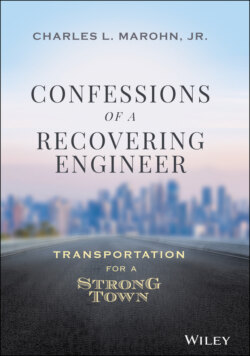Читать книгу Confessions of a Recovering Engineer - Charles L. Marohn Jr. - Страница 17
Roads and Streets
ОглавлениеThe embedded values of the engineering profession prioritize speed and volume in order to maximize mobility, with the belief that increasing mobility is the ultimate good provided by a transportation system. Discarding these antiquated values also allows one to move beyond the hierarchical classification system to one that creates greater value for a local community.
The starting point is the pre-automobile understanding of the difference between a road and a street.
Road: A high-speed connection between two places
Street: A platform for building community wealth
Think of a modern road as a replacement of the railroad, which, as its name suggests, is a road on rails. A railroad does not have frontage railroads or drive-through railroads. That would obviously be silly. For a railroad, a passenger gets on at one place and off at another, with the road providing a high-speed connection between those two places.
A road creates the greatest value by providing the fastest connection between two places that people want to be. This is done by limiting things that slow down traffic along the road. For a railroad, that means reducing the number of stops, the amount of merging traffic, and congestion along the route. For automobile roads, the concept is the same. The higher the sustained speed, the lower the travel time and the greater the value provided by the road.
While roads connect places, streets are the framework for building a place. Streets provide the greatest value when they create places that people want to be. When people choose to buy land, build something on it, and then maintain and improve what is built over time, they are building measurable wealth within the community. The most accurate measurement for the value of a street is the financial productivity of the land adjacent to it — how much value is created per acre of land that abuts the street?
The tension between achieving mobility and providing access in the current model is rightly replaced with the tension of either building a productive place or connecting productive places. This is a financial constraint more than anything else because the wealth created on the community's framework of streets is what must be tapped to pay for building and maintaining both the streets and the roads.
A railroad, again, is the easiest way to think of this system. During westward expansion, major railroad companies established cities along their train routes. They would do minimal development work to establish the community, mostly laying out the network of streets and establishing lots along them. The railroad company would then sell the lots to pioneers, builders, and speculators, who would pay a premium because of the presence of the railroad and the exclusiveness of being located near one of the stops. The profit from improving the land is what the railroad company used to cover the cost of the rail line.
Without a road, a network of streets will have no value. They will not build any real wealth. A city needs connections to other places for the streets to sustain anything beyond a village level of development intensity. The better these connections, the more value they will provide to these places and the more investment the community will attract and retain.
Similarly, a road that fails to connect places to each other is worthless. A circular train that connects back to itself but does not stop anywhere is merely an exercise in frivolity. Connecting one place to another is the minimum threshold a road must meet to be truly viable. That viability, however, will ultimately manifest, and be measured by, the wealth created in the places that it connects.
Roads and streets are yin and yang for city building. They are at cross purposes and antithetical to each other, but both are necessary for ultimate success. We must have great roads that provide high-speed connections between productive places, places that build wealth and prosperity. We must also have great streets that produce enough wealth not only to sustain themselves, but also to fund a proportionate share of the roads that connect them to other productive places.
Degrading roads to make them more street-like, or degrading streets to make them more road-like, reduces the overall value provided by the transportation system.
Thinking of roads and streets in terms of the value they provide, the functional classification chart in Figure 2.1 should be replaced with the chart shown in Figure 2.2. The chart provided in Figure 2.2 places speed along the horizontal axis and value along the vertical, answering the question: Where do transportation investments provide the most value?
Figure 2.2 Which transportation investment provides the most value?
The greatest value is provided where speeds are very low (street) and where they are very high (road). We get the most value from our transportation investments when they are used as the framework for building a productive place, or when they are used to move quickly between productive places. The further an investment strays from these objectives, the less value it provides.
There is a large amount of space in the middle of this chart where increasing speeds reduces value. Once speeds exceed 15 or 20 miles per hour, traffic is moving too quickly for a place to really thrive. Value does not start to be created again until speeds get up above 55 miles per hour; the point where the transportation investment is providing a meaningful level of mobility.
State Street exists in that middle space, as does nearly all of what has been built on the North American continent over the past century. In the classification system of the engineering profession, these are generally called collectors or arterials. I have taken to calling them stroads.
